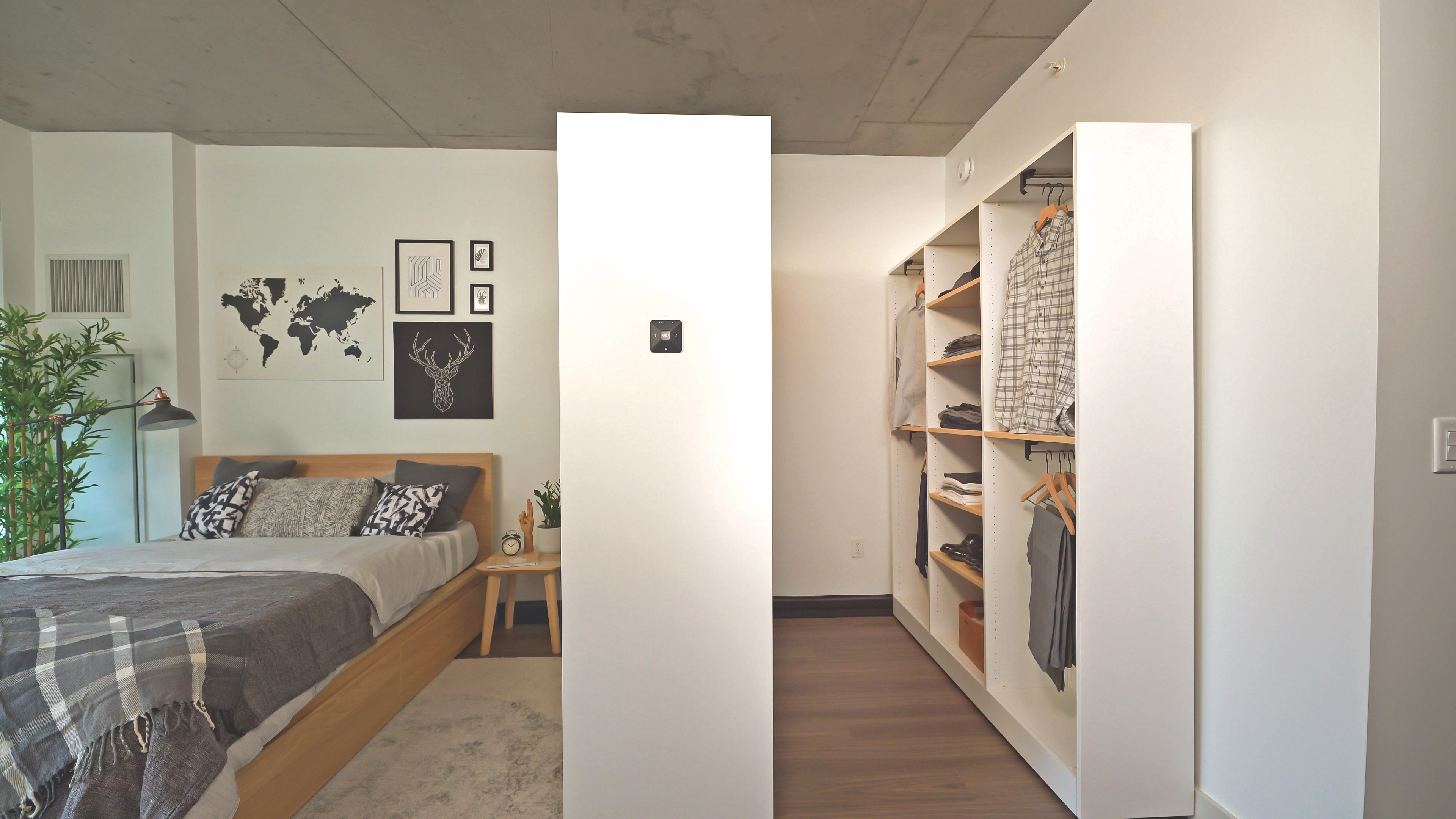As soon as an architect friend showed him a video of the Ori system, Matt Branagh knew it was just what he was looking for. The fourth-generation Owner/CEO of Branagh Development, Lafayette, Calif., saw that Ori could make his studio apartments feel like junior one-bedroom units—perfect, he said, for the “huge wave of people” coming to Oakland from San Francisco to get more space at lower rental cost in a first-class building.
He leased five Studio Suites and purchased eight Pocket Closets for Maya, his firm’s 47-unit apartment building in Oakland, which opened in March. He’s bundling a $275/month premium into the leases for units with a Studio Suite and $95/month for those with a Pocket Closet.
Branagh said tenant adoption for the Pocket Closet was “really strong.” “People get it,” he said. “It’s a price point that they’re willing to pay for, and it’s unique—their friends don’t have it.” He said some prospective tenants were “a little intimidated” working the robotic keyboard at first, but “once they did it a couple of times, they loved it.”
He said Ori turned his floor plans around in 3-4 days and suggested several options. The manufacturer flew in two technicians from Boston to install the systems. They had to do a work-around for the Pocket Closets because the nonmoving section of the two-part system would have bumped into the apartments’ mini-splits. Even so, “the installation was quicker than expected,” just a few days, he said. Branagh has ordered six more.
For Nova Quincy, a 171-unit mixed-use rental community in Quincy, Mass., 10 miles south of Boston, Jonathan Miller, Vice President of LBC Boston, has ordered 40 Studio Suites. “Our prospective tenants are young professionals looking for value outside Boston but close to transit in a lively downtown center,” said Miller. The MBTA Red Line stop is a seven-minute walk.
Nova Quincy will open in September, but already there’s been “a ton of interest” in the Ori system from prospective tenants “looking for something innovative.”
Studio Suites will be installed in 10 studio apartments and 30 micro-units (330–400 sf). “One of the primary benefits of Ori is your usable square footage is much greater”—about 100–150 sf more, he has calculated—“than what you’re paying for.” LBC Boston will include a $200–250 monthly rental premium for what they’re calling “Ori Smart” Studios.
SEE ALSO: Robotic interiors: How to make a studio apartment feel as big as a one-bedroom unit
Miller said he wants to see how the leasing goes for the Ori-outfitted units, but so far he’s “definitely bullish” on using Studio Suites in future projects in Quincy, Allston, and Brighton, where LBC Boston has permitting for 1,500 apartments.
Related Stories
Transit Facilities | Dec 4, 2023
6 guideposts for cities to create equitable transit-oriented developments
Austin, Texas, has developed an ETOD Policy Toolkit Study to make transit-oriented developments more equitable for current and future residents and businesses.
Multifamily Housing | Nov 30, 2023
A lasting housing impact: Gen-Z redefines multifamily living
Nathan Casteel, Design Leader, DLR Group, details what sets an apartment community apart for younger generations.
Products and Materials | Nov 30, 2023
Top building products for November 2023
BD+C Editors break down 15 of the top building products this month, from horizontal sliding windows to discreet indoor air infusers.
Engineers | Nov 27, 2023
Kimley-Horn eliminates the guesswork of electric vehicle charger site selection
Private businesses and governments can now choose their new electric vehicle (EV) charger locations with data-driven precision. Kimley-Horn, the national engineering, planning, and design consulting firm, today launched TREDLite EV, a cloud-based tool that helps organizations develop and optimize their EV charger deployment strategies based on the organization’s unique priorities.
MFPRO+ Blog | Nov 27, 2023
7 ways multifamily designers can promote wellness in urban communities
Shepley Bulfinch's Natalie Shutt-Banks, AIA, identifies design elements that multifamily developers can use to maximize space while creating a positive impact on residents and the planet
MFPRO+ New Projects | Nov 21, 2023
An 'eco-obsessed' multifamily housing project takes advantage of downtown Austin’s small lots
In downtown Austin, Tex., architecture firm McKinney York says it built Capitol Quarters to be “eco-obsessed, not just eco-minded.” With airtight walls, better insulation, and super-efficient VRF (variable refrigerant flow) systems, Capitol Quarters uses 30% less energy than other living spaces in Austin, according to a statement from McKinney York.
MFPRO+ News | Nov 21, 2023
California building electrification laws could prompt more evictions and rent increases
California laws requiring apartment owners to ditch appliances that use fossil fuels could prompt more evictions and rent increases in the state, according to a report from the nonprofit Strategic Actions for a Just Economy. The law could spur more evictions if landlords undertake major renovations to comply with the electrification rule.
MFPRO+ News | Nov 21, 2023
Underused strip malls offer great potential for conversions to residential use
Replacing moribund strip malls with multifamily housing could make a notable dent in the housing shortage and revitalize under-used properties across the country, according to a report from housing nonprofit Enterprise Community Partners.
MFPRO+ News | Nov 21, 2023
Renters value amenities that support a mobile, connected lifestyle
Multifamily renters prioritize features and amenities that reflect a mobile, connected lifestyle, according to the National Multifamily Housing Council (NMHC) and Grace Hill 2024 Renter Preferences Survey.
Sustainability | Nov 20, 2023
8 strategies for multifamily passive house design projects
Stantec's Brett Lambert, Principal of Architecture and Passive House Certified Consultant, uses the Northland Newton Development project to guide designers with eight tips for designing multifamily passive house projects.

















